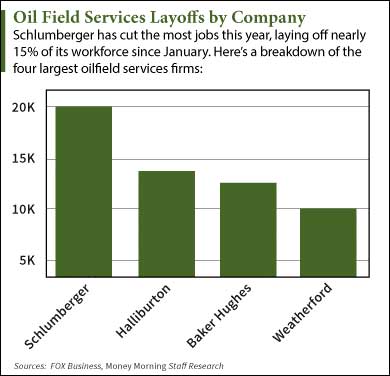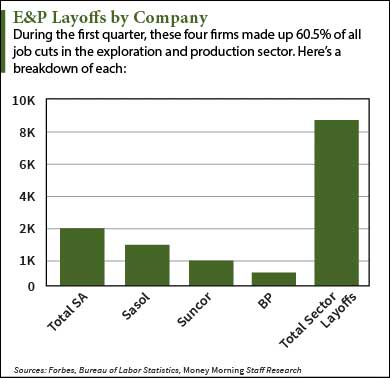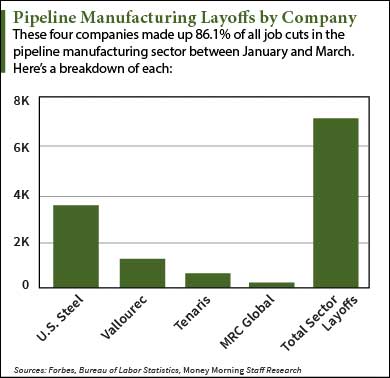[This story was updated Aug. 3, 2015.]
If one number summarizes the oil price meltdown, it's 150,000.
According to Graves & Co., a Houston-based energy adviser that closely tracks layoffs, that's about how many oil jobs have been lost in 2015 as of Aug. 2. It's a massive hit considering about 600,000 people work in the U.S. energy industry.
While layoffs affect office and high-skilled employees, it's mostly the workers laboring in the fields who are at risk.
"The closer your job is to the actual oil well, the more in jeopardy you are of losing that job," said Tim Cook, president of PathFinder Staffing in Houston, to The Wall Street Journal. "Each time an oil rig gets shut down, all the jobs at the work site are gone. They disappear."
Here's a chart-by-chart breakdown of how deep the numbers really go...
How Many Oil Jobs Have Been Lost in 2015, Chart No. 1 - Oil Field Services
 The largest layoffs come from the largest companies - and the oil field services sector has been hit particularly hard.
The largest layoffs come from the largest companies - and the oil field services sector has been hit particularly hard.
As of May 2014, the combined workforce of Schlumberger Ltd. (NYSE: SLB), Halliburton Co. (NYSE: HAL), and Baker Hughes Inc. (NYSE: BHI) made up 43.2% of U.S. energy employees. That number will become more significant once the Halliburton-Baker Hughes merger finalizes later this year.
Schlumberger is the top chopper with about 20,000 layoffs. The company slashed 9,000 jobs in January and cut another 11,000 in April. That constitutes 15% of its employees.
Weatherford International Plc. (NYSE: WFT) has cut about 10,000 jobs so far, roughly 20% of its workforce. Baker Hughes has laid off 13,000 employees, and Halliburton has gotten rid of nearly 14,000 employees.
The reasons why are clear in the Q2 earnings reports. Halliburton posted a 27.2% year-over-year revenue decline due to a constantly falling rig count. Baker Hughes reported a loss of $188 million, or $0.43 a share. Schlumberger saw the worst numbers, with second-quarter profit plunging by 30%.
"The abruptness of the fall in activity, particularly in North America, required us to take additional actions," said Schlumberger CEO Paal Kibsgaard in a statement.
Here are two more charts that show just how large the problem has become...
How Many Oil Jobs Have Been Lost in 2015, Chart No. 2 - Exploration and Production (E&P)
 The E&P sector focuses on finding, producing, and merchandising different types of oil. It's typically known as the upstream area of the oil industry and takes the highest risks when it comes to supply and demand.
The E&P sector focuses on finding, producing, and merchandising different types of oil. It's typically known as the upstream area of the oil industry and takes the highest risks when it comes to supply and demand.
Although they take risks, E&P companies only laid off about 8,362 employees between January and March. That's 85.8% less than the oilfield services sector's 59,000 job cuts over the same period.
French giant Total SA (NYSE ADR: TOT) started cutting jobs after reporting a $5.66 billion net loss for Q4 2014. It announced it will only become profitable at $70 a barrel. The company has laid off 2,000 workers as of March.
Sasol Ltd. (NYSE ADR: SSL) has cut 1,500 jobs as part of capital expenditure cuts and a dividend reduction. Top Canadian player Suncor Energy Inc. (NYSE: SU) has slashed 1,000 jobs and $1 billion from its budget. The smallest cuts have come from BP Plc. (NYSE ADR: BP), which has only laid off 555 workers.
The budget cuts also contributed to falling stock prices during the first quarter. Total SA and Sasol fell 3% and 10.4%, respectively, while Suncor shares dropped 8%.
How Many Oil Jobs Have Been Lost in 2015, Chart No. 3 - Manufacturing
 Steel companies manufacture all of the oil industry's equipment. These firms make everything from drilling pipe and tubing to wellheads and surveillance instruments.
Steel companies manufacture all of the oil industry's equipment. These firms make everything from drilling pipe and tubing to wellheads and surveillance instruments.
Manufacturers are less affected by the price crash because they don't just rely on the oil industry for business. U.S. Steel Corp. (NYSE: X) not only makes pipelines but also automotive, appliance, and construction products. Tenaris SA (NYSE ADR: TS) also produces tubes for industrial applications outside the energy market.
U.S. Steel laid off 3,827 workers in the first quarter - roughly 53.4% of the sector's job cuts. Paris-based Vallourec SA slashed 1,400 jobs over the same period. Luxembourg-based Tenaris and MRC Global Inc. (NYSE: MRC) cut 680 and 270 jobs, respectively.
Follow me on Twitter: @AlexMcGuire92
More on Oil Prices: Investors fear that the tentative agreement with Iran will flood the market with oil and further lower the price. That's what pundits will tell you if they have 30 seconds of airtime to say something. Here's why they're wrong and what to really expect...
Related Articles:
- The Wall Street Journal: Schlumberger Profit Falls 39%; 11,000 More Jobs Cut


